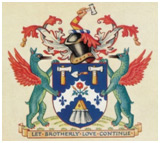The web site of Dr. Claire Gapper
A BIOGRAPHICAL DICTIONARY OF LONDON PLASTERERS 1555-1625
Claire Gapper & Edward Town

Introduction
As decorative plasterwork became increasingly fashionable in the latter sixteenth and early seventeenth centuries, so the demand for plasterers to carry out such work increased. This is reflected in the growing size of the Plasterers’ Company in the City of London during this period but does not seem to have to lead to a rise in their status within the building trades; plasterers are usually listed last and are frequently unnamed in building accounts. The records of the Plasterers’ Company have, however, survived remarkably well from the 1570s and provide the names of men whose careers within the company, and sometimes beyond, can therefore be traced and whose biographies are reconstructed in this dictionary. For an account of the records and the operation of the London Company see the online version of Claire Gapper’s PhD thesis (University of London, 1998) at http://www.clairegapper.info, Chapter III.
It was in 1555 that the first Master Plasterer was appointed in the Royal Works and this milestone has therefore been chosen as the starting date for the dictionary. 1625 not only saw the death of James I but was also a year of terrible plague in London which was particularly devastating among the population of young male adults of the City, bringing the careers of many plasterers to a premature conclusion.
Format of names
Among the numerous variant spellings of names, that closest to modern usage has been chosen as the primary entry, with variations given in capital letters in parentheses.
All those who are known to have been working as plasterers are included but freemen of the Company are distinguished with a capital letter ‘P’. All names shown in bold at first mention within an entry cross-refer to a P/plasterer with his own entry. Apprentices who are not known to have completed their terms are not highlighted in this way, nor are those whose apprenticeships terminated after 1625.
Dates
Dates are given in Old Style, with the year beginning on 25 March, as this was the usage in most records of the time. Dates between 1 January and 25 March are therefore shown with two years, as 1571/2, for example.
As the Court Minutes of the Plasterers’ Company are unpaginated, full date references have been provided.
Abbreviations in footnotes
BL - British Library
GL - Guildhall Library
HHA - Hatfield House Archive
HMC - Historical Manuscripts Commission
LMA - London Metropolitan Archives. When ordering documents at LMA spaces must not be used but this makes references difficult to read in footnotes. A space has therefore been introduced between MS and the number.
TNA - The National Archives